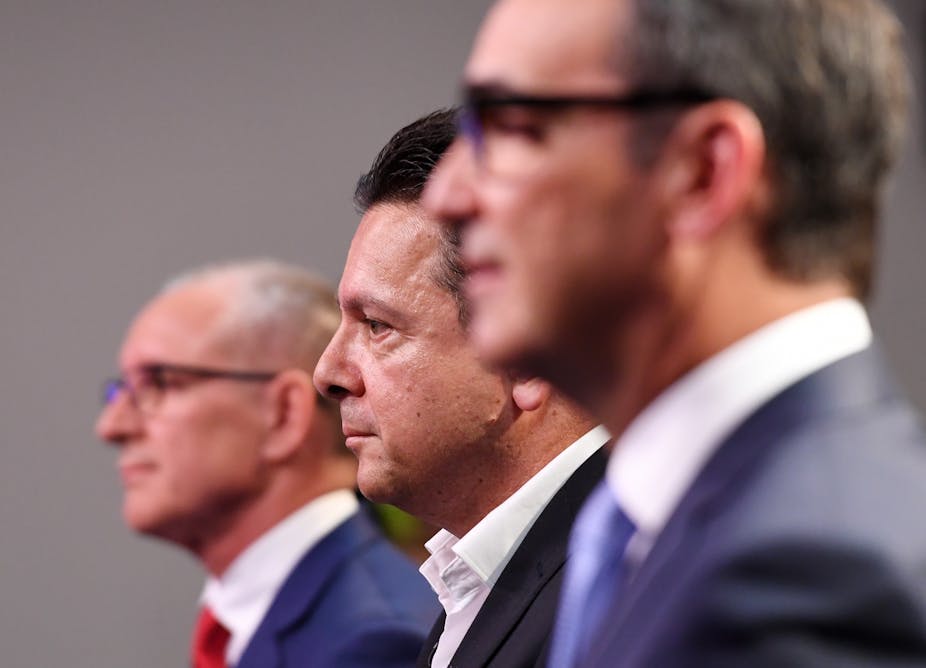Uncertainty is nothing new to South Australia. Over the past decade, the state has faced a range of economic and political unknowns.
In 2014, BHP’s decision not to expand its Olympic Dam site triggered a period of economic uncertainty. A year later, South Australia had the highest unemployment in the nation. Further, the state was hit with the closure of the Holden plant, the uncertainty over the steelworks in Whyalla, and the blackouts of 2016.
The incumbent Labor government, seeking a record fifth term in office, has been active. Premier Jay Weatherill, and his indefatigable treasurer, Tom Koutsantonis, are keen to birth a “new economy” in South Australia. In effect, the government is trying to diversify and strengthen the state since the decline of the resources boom.
As South Australians head to the polls on Saturday, it remains unclear which vision of the state’s future will most likely attract their vote.
Labor is gambling big by spending big. Following classic Keynesian economics, its stimulus agenda includes a A$2 billion infrastructure spend, high-speed internet, extending the tram network, and a bold target of 75% renewables by 2025.
Read more: FactCheck: would pokies reform in South Australia wipe out 'many' of 26,000 jobs?
In contrast, Steven Marshall’s Liberals favour cuts to payroll tax, cuts to electricity bills, and less ambitious infrastructure spending (40,000 homes with solar and batteries, compared with Labor’s 50,000).
In addition, the Liberals have focused on improving electricity inflow from interstate, and new agencies to improve productivity and infrastructure development. They were also pointing to Labor’s policy problems in TAFE, health and – most notably – child protection and mental health.
Marshall has been more sure-footed in his second tilt at outwitting Labor’s formidable electoral machine. He has seemingly put to bed internal party divisions that haunted previous campaigns.
The Liberals are also hoping they can capitalise on a favourable electoral boundary redistribution. The Liberal vote has long been concentrated in rural seats, and Marshall is seeking broader appeal with his vision for a “Strong Plan for Real Change”.
What was looking like a relatively classic Labor versus Liberal fight was thrown into confusion with Nick Xenophon’s return to South Australian politics. An initial honeymoon saw a surge of support for his SA-Best party, now running 36 candidates across the 47 seats in the lower house.
In December, a shock Newspoll result had SA-Best’s primary vote at a huge 32%. Subsequent polls seem to suggest this might have deflated.
Xenophon is seeking to capitalise on what he perceives to the “broken politics” of the old two-party axis, with a tired Labor government and the Liberals with a leader whose personal popularity has rarely exceeded the premier’s.
Xenophon has managed something that Australian politics has not seen since the late 1990s, with a centrist challenger posing an electoral threat to the major parties. The vote for the two major parties has been in decline for some time in Australia. The 2016 federal election produced the largest-ever vote for the minors.
South Australian politics, likes its economy, is also in transition.
Ironically, the surge in support for the SA-Best candidates seems to have had a negative impact on the other minor parties. Polling suggests the vote share for the Greens is down from about 10% to 6%. In the Legislative Council, Kelly Vincent, the Dignity candidate, looks set to lose her seat. Limited media space means the other minors are struggling to get heard.
The other striking development is that this is the first election to test the electoral strength of Cory Bernardi’s Australian Conservatives since their merger with Family First (another party with South Australian origins). The Australian Conservatives have taken up one of Labor’s abandoned causes: to establish a nuclear waste facility in South Australia.
With an electoral race this uncertain and with no clear front-runner, many close seats will come down to preferences and pre-polls.
Remarkably for a leader, Marshall has already cast his vote. Indeed, the Liberals are wagering that like-minded voters will also vote early, and they hope to capitalise on the release of the ICAC report into the abuse at the Oakden mental health facility. The report damaged Labor’s campaign a fortnight out from the polls.
Labor, ever-savvy, is playing a clever game with preferences, splitting the ticket across the state between SA-Best and the Liberals.
Intriguingly, Labor has done a deal with the Australian Conservatives to secure their preferences in three marginal Labor seats (Light, Lee and Newland), in return putting the Conservatives third on their Legislative Council ticket.
On Saturday night, the focus will be on the seat of Hartley – a microcosm of the election. Nick Xenophon will be seeking to beat Liberal incumbent Vincent Tarzia and fend off former ALP minister Grace Portolesi. The outcome of this three-horse race is still uncertain, much like the state’s wider economic and political future.

